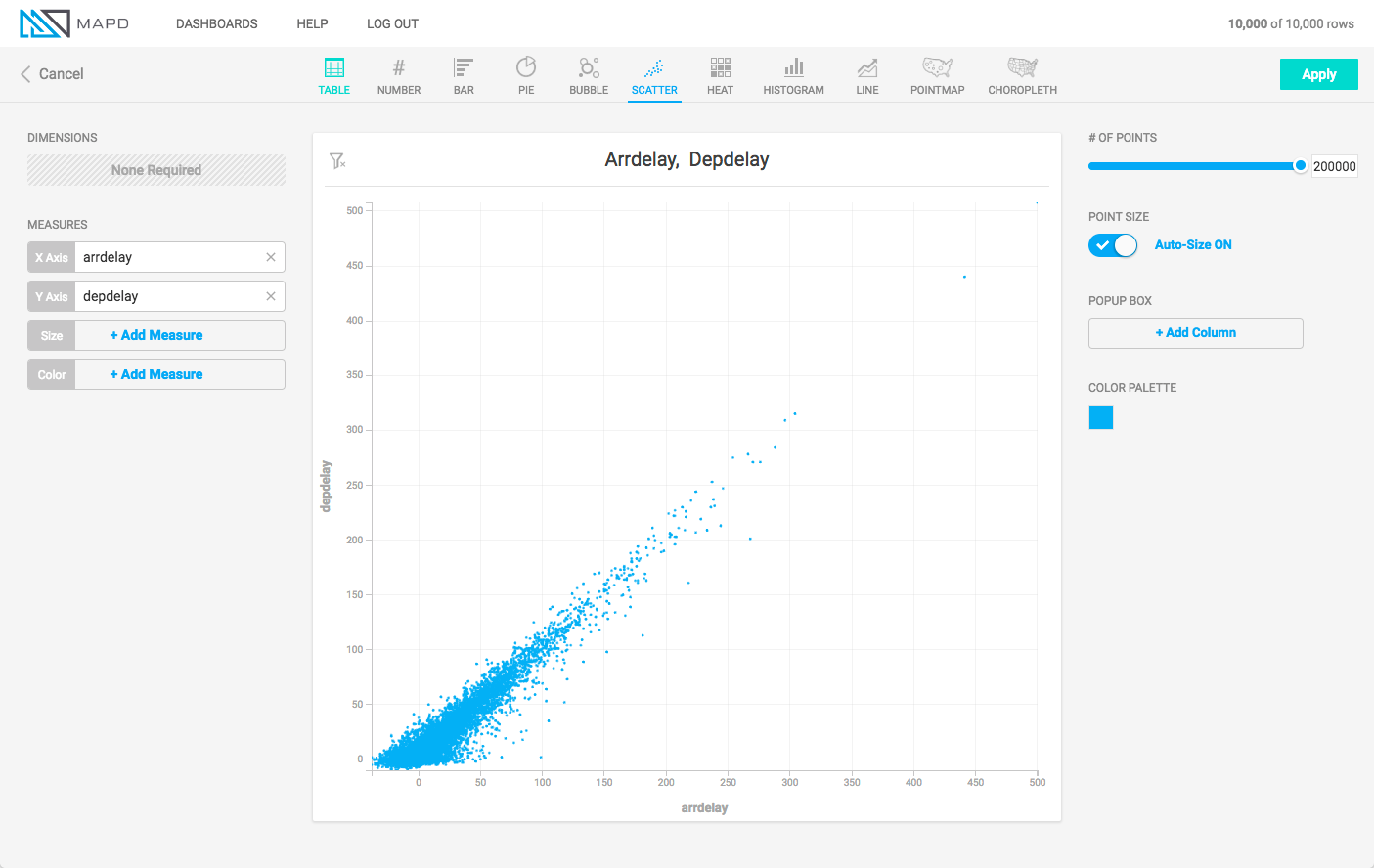CentOS 7 EE GPU Installation With Yum¶
This is an end-to-end recipe for installing MapD Enterprise Edition on a CentOS 7 machine running with NVIDIA Kepler or Pascal series GPU cards using Yum.
Here is a quick video overview of the installation process.
While you will want to keep these written instructions handy to copy and paste many of the installation commands, you can watch a really fast, really cool video overview of these instructions here:
- The installation phases are:
Note: The order of these instructions is significant. Please install each component in the order presented to prevent aggravated hair loss.
Assumptions¶
- These instructions assume the following:
- You are installing on a “clean” CentOS 7 host machine with only the operating system installed.
- Your MapD host only runs the daemons and services required to support MapD.
- Your MapD host is connected to the Internet.
Preparation¶
Prepare your Centos 7 machine by installing EPEL, updating your system, installing CUDA, creating the MapD user, and enabling a firewall.
EPEL¶
Install the Extra Packages for Enterprise Linux (EPEL) repository. RHEL-based distributions require Dynamic Kernel Module Support (DKMS) in order to build the GPU driver kernel modules. For more information, see https://fedoraproject.org/wiki/EPEL.
sudo yum install epel-release
Update and Reboot¶
Update the entire system and reboot to activate the latest kernel.
sudo yum update
sudo reboot
Create the MapD User¶
Create the mapd group and mapd user, who will be the owner of the MapD database. You can create both the group and user with the useradd command and the -U switch.
sudo useradd -U mapd
Install CUDA Drivers¶
CUDA is a parallel computing platform and application programming interface (API) model. It uses a CUDA-enabled graphics processing unit (GPU) for general purpose processing. The CUDA platform gives direct access to the GPU virtual instruction set and parallel computation elements. For more information on CUDA, see http://www.nvidia.com/object/cuda_home_new.html.
MapD does not require the entire CUDA package, only the CUDA drivers. Without following the installation instructions on the CUDA site, download the CUDA RPM for network install (https://developer.nvidia.com/cuda-downloads).
curl -O -u mapd http://developer.download.nvidia.com/compute/cuda/repos/rhel7/x86_64/cuda-repo-rhel7-<VERSION INFO, for example 8.0.61-1.x86_64>.rpm
Use the following commands to install CUDA drivers:
sudo rpm --install cuda-repo-rhel7-<VERSION INFO, for example 8.0.61-1.x86_64>.rpm
sudo yum clean expire-cache
sudo yum install cuda-drivers
Reboot your system to ensure that all changes are active.
sudo reboot
Checkpoint
Go to /usr/lib64/ and verify that the file libcuda.so is in that location.
Firewall¶
To use Immerse, you must prepare your host machine to accept HTTP connections. You can configure your firewall for external access.
sudo firewall-cmd --zone=public --add-port=9092/tcp --permanent
sudo firewall-cmd --reload
For more information, see https://fedoraproject.org/wiki/Firewalld?rd=FirewallD.
Installation¶
- In a web browser, download the MapD list file
https://releases.mapd.com/ee/mapd-ee-cuda.repo.
# Move and rename the file to /etc/yum.repos.d/mapd.repo.
Edit the
mapd.repofile, replacinguser:passwith the user and password given to you by your MapD sales representative.[mapd-ee-cuda] name=mapd ee - cuda baseurl=https://user:pass@releases.mapd.com/ee/yum/stable/cuda gpgcheck=1 gpgkey=https://releases.mapd.com/GPG-KEY-mapd
Use
yumto install MapD.sudo yum install mapd
Configuration¶
These are the steps to prepare your MapD environment.
Set Environment Variables¶
For convenience, you can update bash.rc with the required environment variables.
Go to your home directory.
Use ctrl-h to show hidden files.
Edit the
.bashrc file. Add the following export commands under “User specific aliases and functions.”# User specific aliases and functions export MAPD_USER=mapd export MAPD_GROUP=mapd export MAPD_STORAGE=/var/lib/mapd export MAPD_PATH=/opt/mapd
Save the
.bashrcfile.Open a new terminal window to use your changes.
The $MAPD_STORAGE directory must be dedicated to MapD: do not set it to a directory shared by other packages.
MapD Configuration File (mapd.conf)¶
You can also create a configuration file with optional settings. See Configuration.
Initialization¶
This step initializes the database and prepares systemd commands for MapD.
Run the
systemdinstaller. This script requiressudoaccess. You might be prompted for a password. Accept the values provided (based on your environment variables) or make changes as needed. The script creates a data directory in $MAPD_STORAGE with the directoriesmapd_catalogs,mapd_data, andmapd_export.mapd_importandmapd_logdirectories are created when you insert data the first time. Themapd_logdirectory is the one of most interest to a MapD administrator.cd $MAPD_PATH/systemd sudo ./install_mapd_systemd.sh
Activation¶
Start and use MapD Core and Immerse.
Start MapD Core
cd $MAPD_PATH sudo systemctl start mapd_server sudo systemctl start mapd_web_server
Enable MapD Core to start when the system reboots.
sudo systemctl enable mapd_server sudo systemctl enable mapd_web_server
Checkpoint
To verify that all systems are go, load some sample data, perform a mapdql query, and generate a pointmap using Immerse.
MapD ships with two sample datasets of airline flight information collected in 2008. To install the sample data, run the following command.
cd $MAPD_PATH
sudo ./insert_sample_data
When prompted, choose whether to insert dataset 1 (7 million rows) or dataset 2 (10 thousand rows).
Enter dataset number to download, or 'q' to quit:
# Dataset Rows Table Name File Name
1) Flights (2008) 7M flights_2008_7M flights_2008_7M.tar.gz
2) Flights (2008) 10k flights_2008_10k flights_2008_10k.tar.gz
Connect to MapD Core by entering the following command in a terminal on the host machine (default password is HyperInteractive):
$MAPD_PATH/bin/mapdql
password: ••••••••••••••••
Enter a SQL query such as the following:
mapdql> SELECT origin_city AS "Origin", dest_city AS "Destination", AVG(airtime) AS
"Average Airtime" FROM flights_2008_10k WHERE distance < 175 GROUP BY origin_city,
dest_city;
Origin|Destination|Average Airtime
Austin|Houston|33.055556
Norfolk|Baltimore|36.071429
Ft. Myers|Orlando|28.666667
Orlando|Ft. Myers|32.583333
Houston|Austin|29.611111
Baltimore|Norfolk|31.714286
Connect to Immerse using a web browser connected to your host machine on port 9092. For example, http://mapd.mycompany.com:9092.
Create a new dashboard and a pointmap to verify that backend rendering is working.
- Click New Dashboard.
- Select the flights_2008_10K table as the datasource.
- Click Connect to Table.
- Click Add Chart.
- Click SCATTER.
- Click X Axis +Add Measure.
- Choose
arrdelay. - Click Y Axis +Add Measure.
- Choose
depdelay.
The resulting chart shows, unsurprisingly, that there is a correlation between departure delay and arrival delay.
